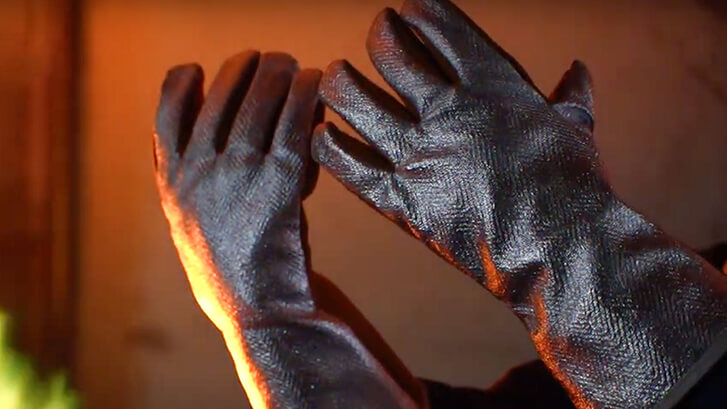When you’re working in extreme heat, choosing the right gloves isn’t just about comfort—it’s about protecting yourself from the dangers of hazardous industrial work.
That’s where heat-resistant gloves come in. They shield your hands during heavy-duty tasks like metalwork, welding, or any job involving high temperatures.
This article is your guide to understanding heat-resistant gloves and choosing the correct pair for your needs. Whether you work in an industrial setting or need reliable heat safety for other tasks, this guide will aid you in making a wise decision.
What are Heat-Resistant Gloves?
Heat-resistant gloves are an essential part of PPE. They provide a protective layer for your hands in environments where high temperatures pose a risk. Acting as a barrier, they help maintain safety in welding stations, metal shops, or industrial kitchens.
A good-quality pair does more than just protect. They offer a flexible fit for better movement and dexterity when handling hot tools. At the same time, they ensure comfort by conforming organically to the shape of your hand.
- Temperature Threshold: Always check the maximum temperature the gloves can handle. Some can only resist light heat, while others withstand extreme temperatures.
- Exposure Time: Consider the duration for handling hot items. Some gloves protect well for short contact, while others can manage long durations of heat exposure.
- Dexterity and Fit: Heat protection shouldn’t come at the cost of usability. Gloves should allow for movement and control without compromising safety.
- Layering and Lining: Look for gloves with multiple protective layers that help manage both heat resistance and comfort.
- Material Type: The construction material greatly affects performance, which leads us to the next section.
How Glove Materials Affect Heat Resistance
Types of Heat
To choose the right heat-resistant gloves, we first need to understand the different types of heat. This is essential as not every material can provide safety against all heat types.
Here are the different types you may encounter in industrial settings:
- Convection occurs when you’re exposed to environments with extremely hot temperatures, like working near an industrial oven.
- Conduction is the conduction of heat when you make direct contact with a heated surface, for example, handling hot tools.
- Radiation is when you feel the rise in temperature from a source, even at a distance, such as working near a furnace.
- Fire & Flames pose a risk when you’re working in conditions with open flames around you.
- Hot spills can take place when dealing with extremely hot liquids in the factory.
Types of Materials
Now that we know various types of heat affect materials differently, let’s look at different materials used in the manufacturing of heat-resistant gloves:
- Kevlar: Used primarily in the automotive industry when working with metals. This material provides great protection against cuts and heat. That’s why it’s a preferred choice for handling sharp tools and working in extremely hot conditions.
- Leather: A common choice for welding and heavy-duty work. It is naturally heat-resistant and durable, works well against sparks, friction, and moderate heat.
- Nomex: Often worn in electrical and fire response settings. Manufacturers often use Nomex to compose fire-resistant PPE as it can resist high temperatures without melting.
- Aluminised Fabric: What types of gloves provide thermal protection? Gloves made with aluminised fabric are a prime example, as they reflect radiant heat and shield workers during furnace operations like molten metal handling.
- Carbon Fiber: Applied in high-heat manufacturing settings. It can hold its quality even in extreme temperatures. Moreover, it is often layered with other materials for enhanced performance and dexterity.
Now that we’ve covered the types of heat encountered in industrial settings and the materials used to manufacture protective gloves, it’s time to look at how safety experts choose the right ones. It’s not just about choosing any pair off the shelf. There’s a clear, structured process behind each choice—one that ensures the gloves can handle the job safely.
We now need to look at how the safety experts pick the right gloves for handling heat in industrial settings. It’s not just matter off selecting any pair off the shelf; there’s a clear, structured process behind it that ensures the gloves can handle the job safely.
Understanding the Varying Levels of Heat Protection
When it comes to choosing gloves, professionals rely on specific benchmarks that test how well gloves hold up against heat. These standards help make sure the gloves perform well under extremely high temperatures.
Here’s a quick rundown of the key standards used:
- EN 407 (Europe): This standard evaluates gloves based on how they perform against different thermal risks, like direct flames, contact with hot surfaces, radiant heat, or even splashes of molten metal.
- ASTM F1060 (USA): This one focuses on thermal protection, measuring how much heat a glove can block and for how long. It’s especially useful for jobs like welding or working near furnaces where intense heat is common.
- Contact Heat Testing: Gloves are tested to see how long they can withstand hot surfaces.
- Task-Specific Ratings: Some gloves are rated specifically for certain jobs, like welding or working near furnaces, to ensure they’re a perfect fit for the conditions workers face.
By using these standards, safety managers can confidently choose gloves that match the level and type of heat workers will encounter, keeping safety first without any guesswork.
Conclusion
Choosing the right heat-resistant gloves isn’t just about picking a pair that is of good quality. It is more about understanding the type of heat you’re exposed to, the material best suited for the task, and the protection level required by industry standards.
Visit https://elite-leather.com/ and choose a pair of gloves that are the best fit for you.


